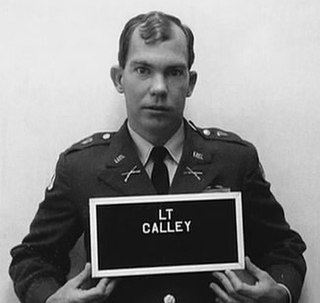
William Laws Calley Jr. is a former United States Army officer and war criminal who was convicted by court-martial for the murder of 22 unarmed South Vietnamese civilians in the My Lai massacre on March 16, 1968, during the Vietnam War. Calley was released to house arrest under orders by President Richard Nixon three days after his conviction. A new trial was ordered by the United States Court of Appeals for the Fifth Circuit but that ruling was overturned by the Supreme Court. Calley served three years of house arrest for the murders. Public opinion at the time about Calley was divided. Since his dismissal from the U.S. Army and release from prison, Calley has avoided public attention.

The United States Disciplinary Barracks (USDB), colloquially known as Leavenworth, is a military correctional facility located on Fort Leavenworth, a United States Army post in Kansas. It is one of two major prisons built on Fort Leavenworth property, the other is the military Midwest Joint Regional Correctional Facility, which opened on 5 October 2010. It reports to the United States Army Corrections Command and its commandant usually holds the rank of colonel.

Michael (Stewart) Waddington is an American criminal defense lawyer specializing in court-martial cases, war crimes, and other serious felonies. He defended Sgt. Alan Driver, accused of abusing detainees, and Specialist Hunsaker in the Operation Iron Triangle Case.

Duncan Duane Hunter is an American former politician and United States Marine who served as a U.S. representative for California's 50th congressional district from 2013 to 2020. He is a member of the Republican Party, who was first elected to the House in 2008. His district, numbered as the 52nd from 2009 to 2013, encompassed much of northern and inland San Diego County and a sliver of Riverside County, including the cities of El Cajon, Escondido, San Marcos, Santee and Temecula. He served in the U.S. Marines from 2001 through 2005 and succeeded his father, Republican Duncan Lee Hunter, a member of Congress from 1981 to 2009.
Members of the United States Armed Forces have violated the law of war after the signing of the Hague Conventions of 1899 and 1907 and the signing of the Geneva Conventions. The United States prosecutes offenders through the War Crimes Act of 1996 as well as through articles in the Uniform Code of Military Justice. The United States signed the 1999 Rome Statute but it never ratified the treaty, taking the position that the International Criminal Court (ICC) lacks fundamental checks and balances. The American Service-Members' Protection Act of 2002 further limited US involvement with the ICC. The ICC reserves the right of states to prosecute war crimes, and the ICC can only proceed with prosecution of crimes when states do not have willingness or effective and reliable processes to investigate for themselves. The United States says that it has investigated many of the accusations alleged by the ICC prosecutors as having occurred in Afghanistan, and thus does not accept ICC jurisdiction over its nationals.

Beaudry Robert "Bowe" Bergdahl is a former United States Army soldier who was held captive from 2009 to 2014 by the Taliban-aligned Haqqani network in Afghanistan and Pakistan.

Michael Chase Behenna is a former United States Army First Lieutenant who was convicted of the 2008 murder of Ali Mansur Mohamed during the occupation of Iraq. Behenna is colloquially associated with a group of U.S. military personnel convicted of war crimes known as the Leavenworth 10. He was sentenced to 25 years imprisonment, which was later reduced to 15 years, and served his sentence in the United States Disciplinary Barracks on Fort Leavenworth, a United States Army post in Kansas. He was granted parole on March 14, 2014, after serving less than five years of his sentence. Since his release from prison he has worked as a farmhand. On May 6, 2019, Behenna received a pardon from President Donald Trump.

Donald Mitchell Brown, Jr. is an American author, attorney, and former United States Navy JAG Officer. He has published fifteen books on the United States military, including eleven military-genre novels, the best known of which is Treason (2005) in which radical Islamic clerics infiltrate the United States Navy Chaplain Corps. He has published four works of military nonfiction, including his national bestseller, The Last Fighter Pilot: The True Story of the Final Combat Mission of World War II (2017). Brown may be best known for his work as legal counsel to Army Lieutenant Clint Lorance, who had been convicted of murder by a military court-martial at Fort Bragg when his platoon became involved in a firefight in Afghanistan in 2011, and his authorship of the 2019 book Travesty of Justice: The Shocking Prosecution of Lt. Clint Lorance. On November 15, 2019, President Donald Trump pardoned Lorance, and the book is considered to be a factor in leading to that pardon. Between the release of Travesty of Justice on March 31, 2019, and Lorance's pardon on November 15, 2019, Brown made numerous national television appearances and penned a number of national Op-eds urging President Trump to free and exonerate Lieutenant Lorance. On the Wednesday night before Thanksgiving, November 27, 2019, Brown and Lorance appeared on Hannity, the nightly national broadcast on the Fox News Channel to discuss the presidential pardon and release.

The Maywand District murders were the thrill killings of at least three Afghan civilians perpetrated by a group of U.S. Army soldiers from January to May 2010, during the War in Afghanistan. The soldiers, who referred to themselves as the "Kill Team", were members of the 3rd Platoon, Bravo Company, 2nd Battalion, 1st Infantry Regiment, and 5th Brigade, 2nd Infantry Division. They were based at FOB Ramrod in Maiwand, in Kandahar Province of Afghanistan.

Peter Brian Hegseth is an American television host and author.

Robert Bales is an American mass murderer and former Army sniper who killed 16 Afghan civilians in a mass shooting in Panjwayi District, Kandahar Province, Afghanistan, on March 11, 2012 – an event known as the Kandahar massacre.
Major Mathew L. Golsteyn is a United States Army officer who served in the War in Afghanistan. He was charged with murder after killing an Afghan civilian in Marjah, whom he claims was a bomb maker for the Taliban. Golsteyn's case came to prominence after U.S. President Donald Trump said that he would review Maj. Golsteyn's case. Golsteyn was pardoned on 15 November 2019.

Travesty of Justice: The Shocking Prosecution of Lt. Clint Lorance is a 2019 book of creative nonfiction written by Don Brown, about the United States Army’s prosecution of Lieutenant Clint Lorance. Lorance, a former paratrooper with the Army's 82nd Airborne Division, was convicted in 2013 for murder by an army court-martial for ordering Private E-2 David Shilo to fire on three Afghan men who had been riding a motorcycle toward their position in Kandahar Province, Afghanistan, in 2012. Lorance was sentenced to twenty years imprisonment. The book discusses what Brown contends are numerous efforts by Army prosecutors to coverup evidence of Lorance's innocence, including biometrics evidence that he argues links the motorcycle riders shot by Lorance's men to bombmaking that killed American troops in the Afghan War.
Edward R. Gallagher is a retired United States Navy SEAL. He came to national attention in the United States after he was charged in September 2018 with ten offenses under the Uniform Code of Military Justice. In the most prominently reported offense, he was accused of fatally stabbing an injured 17-year-old ISIS prisoner, photographing himself with the corpse, and sending the photo to friends.
Derrick Miller is a former US Army National Guardsman sergeant who was sentenced in 2011 to life in prison with the chance of parole for the murder of an Afghan civilian during a battlefield interrogation. Miller is colloquially associated with a group of U.S. military personnel convicted of war crimes known as the Leavenworth 10. After being incarcerated for eight years, Miller was granted parole and released in 2019. He currently serves as the Executive Director of the Justice for Warriors Caucus and Military Adviser to Texas Republican U.S. Representative Louie Gohmert.

The reception of individuals guilty of violations of international criminal law after a conflict differs greatly, ranging from bringing them to justice in war crimes trials to ignoring their crimes or even glorifying them as heroes. Such issues have led to controversies in many countries, including Australia, the United States, Germany, the Baltic states, Japan, and the former Yugoslavia.
War crimes in Afghanistan covers the period of conflict from 1979 to the present. Starting with the Soviet invasion of Afghanistan in 1979, 40 years of civil war in various forms has wracked Afghanistan. War crimes have been committed by all sides.













